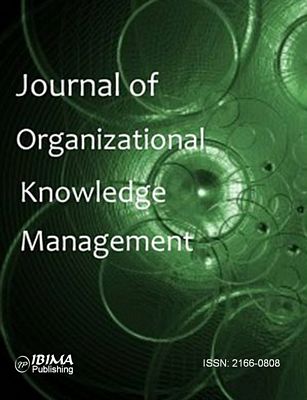Introduction
This huge expectation of the society has put a high pressure on IHLs’ stakeholders in terms of organizing knowledge shared, distributed, and reused freely in the institutions. Many research studies suggested to the IHLs’ knowledge organisation and knowledge management to support the stakeholders’ expectation. However, there are still loopholes in the process of organising and managing knowledge. The knowledge organisation and knowledge management approaches must suit to the dynamic and multi-dimensional components of the IHLs.
Taxonomy approach is supporting dynamic and multi-dimensional components and has been introduced to classify living things. It was then applied to the other areas using the concept of classification, controlled vocabulary, and thesaurus. Well-developed taxonomy is able to act as a single central reference, and therefore eliminates the problem of distributed knowledge source in the organisation.
Literature Review
Roles of Knowledge
The researcher has found and analysed 14 academic articles that highlight the roles of knowledge in IHL. The results of analysis, organised by education, industry and government sectors, are depicted in Table 1.
Table 1: Roles of Knowledge in Education, Industry and Government
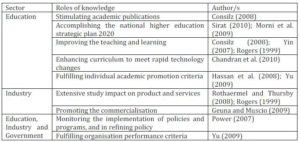
The nine important roles of knowledge in the three sectors shown above reveal the role of knowledge and its contribution to the development of human capital that is important for country development. IHL contributes by stimulating knowledge exchange, conducting knowledge base activities like workshops, seminars and conferences, and producing graduates that fulfil the requirements of the industries.
Knowledgeable societies and communities are expected to contribute to the economy and development of countries. While knowledge plays an important role in country development, in the knowledge providers’ environment (IHL); knowledge has not being optimised (Barnett 2000; Mohayidin et al. 2007; Geuna and Muscio 2009). Among the issues are i); knowledge is not supporting decision making (Rahman and Hamidi 2006;Daud 2010; Morni et al. 2009; Hamidi and Jusoff 2009), ii); knowledge is scattered (Hamidi and Jusoff 2009, Rahman and Hamidi 2006), iii); knowledge is unstructured (Mohayidin et al. (2007) and, Hamidi and Jusoff (2009), iv); knowledge is not recognised as strategic knowledge asset ((Rahman and Hamidi 2006, Metcalfe 2006); and finally v) knowledge is not classified and presented as a central and as a standard element (knowledge taxonomy) (Lambe 2011; Abdullah et al. 2004). All of these problems laid the foundation of this research (Basaruddin et al. 2013).
The researchers of the previous studies related to knowledge in IHL also proposed a few solutions related to managing IHL knowledge. Hassim et al. (2005) and Mohayidin et al. (2007) proposed a general knowledge management system for IHL; Hamidi and Jusoff (2009), Rahman and Hamidi (2006) and Basaruddin and Haron (2011), developed Organisational Memory Information System (OMIS) and Organisational Memory System (OMS). All of the solutions suggested a computer-based system to manage knowledge.
Anyhow, Sheng et al. (2010) found that developing more computer-based systems shall not help in finding a solution to the scattered knowledge asset. Instead, this will actually invent more distributed knowledge resources instead of the unmanaged existing ones. Due to that, taxonomy approach has been highlighted to provide an alternative solution to manage existing knowledge resources in IHL.
Taxonomy is able to act as a map of knowledge domain (Nickerson 2009). Lambe (2011) and Wyllie et al. (2011) clearly mention that knowledge taxonomy could provide standard and common understanding of subjects in organisations. Malafsky (2011) describes knowledge taxonomy as being precise, does not overlap, has independent content, reflects organisational access needs and is a recognised industry standard.
Therefore taxonomy is able to be the centralized reference and to solve the scattered knowledge assets issues. Knowledge taxonomy focuses on ensuring efficient knowledge sharing and access among organisational members (Sharma et al. 2010; Nickerson 2009; Malafsky 2011).
The Advantages of Having Taxonomy
Taxonomy offers huge benefits and is crucial for the processing, storage, management and searching of knowledge in organisations (Subramaniam et al. 2010; Jung 2008). It has universal applications of grouping knowledge so that it can be systematically developed, stored and reused (Malafsky 2011). The following table elaborates on five advantageous points of taxonomy derived from the literature review.
Table 2: Advantages of Taxonomy
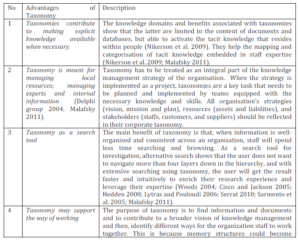
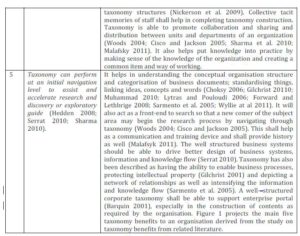
As the foundation for all activities within the corporation is related to documents, taxonomy can gather a wide range of corporate objectives, such as enabling business processes, protecting intellectual property, and building the foundation for compliance (Gilchrist 2001). Ultimately, taxonomies need to reflect the working environment and culture of the organisation for which they are created (Wyllie et al. 2011).
Since working environments change continuously, taxonomies should also be flexible and adaptive to the changing environment (Cisco and Jackson 2005). This study shall address taxonomy from the dimensions of knowledge for IHL. Before that, the study explores on taxonomy applications, concepts and approaches.
Taxonomy Applications
Taxonomy is a structured and classified information and knowledge in an organisation (Nikerson et al. 2009; Sharma et al. 2008; Lytras and Pouloudi 2006; Malafsky 2011]). In managing Science and Information System (IS) fields, the importance of taxonomy is well recognised (Sharma et al. 2010). This is agreed by Malafsky (2008) when he notes that in information sciences, the study of CT has been subject to considerable and longstanding interest among both researchers since the 90’s. Lambe (2011) in his presentation of “Taxonomies and Knowledge Management” revealed a survey results of 187 taxonomy professionals conducted from September to October 2009.
The ecosystem of taxonomy work shows taxonomy related work has been done in various disciplines. They are most populated in information and knowledge management, information science, and library science domain order by most popular domains. Following them are linguistic, information technology, cognitive psychology and business analytics domains in descending order. Other than that are philosophy, management, publishing and editorials, respectively.
Taxonomy concept has been applied to wider disciplines and domains. Most taxonomy applications have been practiced in the area of content management and metadata management, followed by archives and records management, digital asset management, document management, information architecture and data management.
Zooming to the sub-level of the taxonomy work ecosystem, taxonomies have been applied to intranet management, usability design, text mining and web management followed by business management and research management. Other application areas include instructional design, IT management, software design, system analytics and technical writing.
Lambe (2007) study was supported by Lars (2004) and Muhammad et al. (2010) who claimed that taxonomy was used to start knowledge management (KM) project. Figure 1 projects taxonomy applications in various domains.
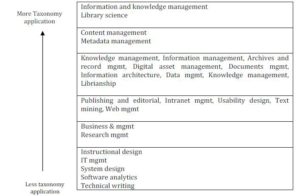
Fig 1. Taxonomy Work (Lambe, 2011)
Lambe (2011) has not directly included education domain in his study. The researcher noticed that from the lens of education, the taxonomy application falls mostly under information, knowledge management and information technology domain.
Bloom’s taxonomy is the widely used taxonomy in education domain (Gina and Russel 2004). Some other examples of taxonomies in education can be found on Taxonomy Warehouse website: ‘Cyc Education Taxonomy Suite’, ‘Education, Skills & Children’s Services Thesaurus’, ‘Gale Education Thesaurus’ and ‘WAND Education & Training Taxonomy’.
While other taxonomies might be used internally in academic institutions, initial inspection through observation and semi-structured interviews at one public academic institution in Selangor, Malaysia noticed taxonomy has been used in administration that is in filing — in assigning filing code and letter reference code.
Other than library classification system being used, the usage of Bloom’s taxonomy and filing taxonomy are the evidence that taxonomy has been used at institutions level (corporate taxonomy) and is a clear proof that taxonomy is one way to record tacit knowledge, manage internal information, as part of search tool, support way of working and as initial navigation level of related subject in IHL. Researcher believes that there’s a lot more opportunities in classifying unstructured knowledge in these institutions.
Taxonomy Concepts
In the category of semantic taxonomy, word taxonomy has been interchangeably used with classification and structure (Cisco and Jackson 2005; Nickerson 2009; Sharma et al. 2008; Lytras and Pouloudi 2006; Lambe 2011). Taxonomy has also been related to a controlled vocabulary and thesaurus. In order to understand taxonomy clearly, the researcher digs into taxonomy related words from Lambe 2(007).
The findings show that the three words (classification, controlled vocabulary, and thesaurus) have established a relationship with taxonomy. The basis of semantic taxonomy is when the items are classified. Classified items when sorted into alphabetical order become controlled vocabulary, and the latter when assigned a relationship with others will become thesaurus.
When dealing with bases of explicit knowledge stored in electronic format, any taxonomy utilised is tightly coupled with the body of metadata utilised to define, identify, point, describe and characterize the contents of the knowledge base (Lambe 2007). Sharma et al. (2010) have come up with Functionalities of Taxonomy Builders and Classifiers that project all the main components related to taxonomy.
Gina and Russell (2004) and Lambe (2007) categorised knowledge taxonomy into three main features or types: classification scheme, semantic representation, and knowledge map. Nickerson et al. (2009) gave an example of established classification scheme as Dewey Decimal Classification (DDC) mostly uses in libraries.
An example of semantic representation given was a search engine while the knowledge map concept was said to assure the global picture of a scenario or condition.
In most taxonomy descriptions, taxonomy has been reflected in the form of a hierarchy. This is argued by Lambe 2011). He elaborated the taxonomy form could be from a simple list to a complex system map. Sharma et al. (2008) in theirfunctionalities of taxonomy builders and classifiers mentioned four basic forms of taxonomy that are tree or node, map, star (polyhierarchies) and folder (list).
Lambe (2007) reveals additional three forms from Sharma et al. (2008) that are: hierarchies, matrices and facets. Each form has its own usage preference and level of complexity. The levels of complexity generally increase from list to system maps. Table 3 depicts the taxonomy forms (Lambe, 2007 and Sharma et al., 2008) and Table 4 summarises the representation levels of taxonomy forms (Lambe 2007).
Table 3: The Taxonomy Forms

Table 4 : The Complexity and Representation Level
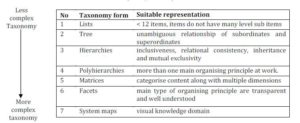
Besides the above suitable criteria for choosing taxonomy forms, complexity of the taxonomy is also found to be a deciding factor for choosing the right taxonomy form. The investigator found out from the literature (Lambe,2007; Sharma et. al, 2008) that the number of words is aligned with the degree of complexity for each taxonomy form.
System maps support the most complex taxonomy forms and huge numbers of vocabularies. While the list is the simplest form of taxonomy, it would contain few vocabularies. Trees, hierarchies, polihierarchies, matrices and facets are supporting simple to complex taxonomy form ranging from a small number of vocabularies to a bigger one.
While analysing articles about taxonomy, the researcher found mutual understanding of taxonomy. Taxonomy project should involve controlled vocabularies, logical business arrangements and some representations of specific domain in conceptual map, for the purpose of generalisation in the organisation.
Taxonomy Development Approaches
The simplest taxonomy development stages done by Malafsky 2008 consist of two levels: information and knowledge identification, and Draft taxonomy development, while Sharma et al. 2008, Whittaker and Breininger (2008), Connelly 2007, Nie et al. 2007& woods 2004 went through five levels of taxonomy development phases that are: i) Information and knowledge identification, ii) Taxonomy draft development, iii) Taxonomy draft testing and verification, iv) Taxonomy finalisation and finally v) Taxonomy presentation. Table 5 depicts the compilation taxonomy development phase from the literature.
Table 5: Compilations of Taxonomy Development Phase
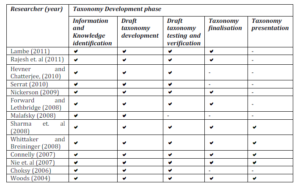
On average, the thirteen taxonomist compilations of taxonomy development phase show there is an agreement on the development phases of taxonomy that consists of i) information and knowledge identification phase, ii) draft taxonomy development phase, iii) Draft taxonomy testing and verification phase and taxonomy finalisation. Five taxonomists added a fifth phase that is v) taxonomy presentation phase. Some taxonomists include the taxonomy presentation during the finalisation of taxonomy phase.
Methodology
In this study, the researcher uses document analysis method to extract the literature review of taxonomy concept and approaches, and the knowledge organization and management of IHL. The articles from various journals, conferences, books and technical papers related to knowledge taxonomy and academic institutions were analyzed using thematic analysis. There are six themes analyzed and depicted in Table 6.
Table 6: Thematic Analysis
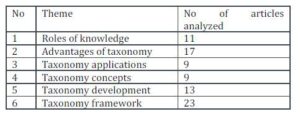
For knowledge organization and management issues, the researcher conducted semi-structured interviews and observation at one public academic institution in Selangor, Malaysia. A semi-structured interview involved one person who is in charge of IT in main library, one person in charge of archive unit, one person in charge of IT in research unit, and two coordinators of one faculty.
The interview aimed at investigating and exploring taxonomy usage in academic background. The two coordinators and three heads of curriculum units were also interviewed to investigate knowledge assets in IHL.
The sub-study of knowledge assets in the IHL, also supported by document analysis, involved published vision, mission, strategic planning and all documents in curriculum unit shared links published through curriculum unit websites. Using the thematic analysis approach, it was found that curriculum management is among the most important items addressed and therefore must be organized and managed wisely by the IHL.
Result
As a result of knowledge assets studied in IHL, this exercise focuses on curriculum management. Different scenarios project different taxonomies; most of the time, produced taxonomies only matched the studied environment and requirements. Since there is a limited amount of knowledge taxonomy in IHL context produced before, a specific and comprehensive study is necessary (Abdullah et al. 2004).
Developing specialised and dedicated taxonomy, in its environment, is an advantage because it will not be influenced by the classification of an item that is not necessary or does not even exist in IHL. Lambe (2007) emphasised taxonomy as artificial memory.
The action is supporting the final outcome of taxonomy produced; shall be applied as content in developing a corporate memory system (CMS) for the IHL. Figure 2 projects the proposed framework where corporate taxonomy could be used as content in CMS.
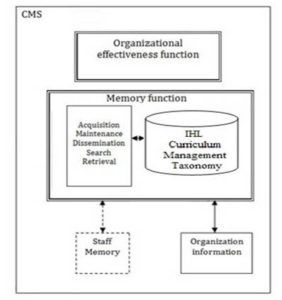
Fig 2. Conceptual Framework of IHL CMS Focusing on Curriculum Management
As a knowledge producer, IHL should play its role in managing knowledge. One of the ways to manage it is by preserving the memories in IHL; that is by having a CM. CM with the use of technology is able to act as a centralizeknowledge repository (the CMS).
CT shall provide pertinent knowledge structure required by IHL. Therefore, as an alternative to manage and reuse corporate knowledge in corporate memory system, this study presents a new approach by optimising corporate taxonomy that has been said to provide various benefits to organisations.
In the proposed framework, the strategic content will be structured and classified (as CT) to fit in as CMS content provider. CMS model is adapted from Stein and Zwass (1995) Organisational Memory Information System (OMIS) model.
This model is going to be used as the basis in developing a CMS prototype for IHL. Selection of appropriate model has been based on literature study on CMS model.
OMIS model by Stein and Zwass (1995) has been divided into two functions that are effective and mnemonic functions. In effective function the model concentrates on integration, adaptation, goal attainment, pattern and maintenance, while in mnemonic function, the model has been focusing on knowledge acquisition, retention, maintenance and finally search and retrieval.
Conclusions
As a complex entity that is approximate to knowledge, IHL has to take the responsibility to organise and manage knowledge so that it is available for the needs of community and society of knowledge. One approach that supports the complexity of the academic environment is taxonomy approach. The latter has not being explored extensively in IHL.
As a straight forward approach, it offers a high flexibility for supporting complex knowledge organisation and management in IHL. CM in IHL should be organised and manageable using the taxonomy approach so that it can be retained extensively in the dynamic academic environment.
A detailed literature study was done and the findings have been derived to form the conceptual framework of the CMS in IHL. While the framework has drawn some lines for the study, a specific scope focusing on strategic knowledge assets of IHL is necessary to be used as a benchmark for the study. Data collection of the study should be based on the specific strategic knowledge assets of IHL before they are presented in the form of taxonomy as a content of the CMS.
Acknowledgment
Thank you Research Management Institute UiTM for sponsoring this research under grant number 600-RMI/DANA 5/3/RIF (553/2012).
References
Abdullah, R., Shahabudin, S., Alias, R. A. & Selamat, M. H. (2004). ‘The Development of Knowledge Management System for Public Higher Learning in Collaborative Environment Using Lotus Notes Software,’ Proceedings of Knowledge Management International Conference and Exhibition (KMICE) 2004, 14-15 February 2004, Penang, Malaysia, 454-465.
Abdul Rahman, A. & Hamidi, S. R. (2006). “Organisational Memory Information System Case Study in Faculty of Computer Science and Information System UTM,” International Conference on Technology Management, 4-5 December 2006, Putrajaya, Malaysia, 1-14.
Publisher
Barnett, R. (2000). “University Knowledge in an Age of Super Complexity,” Higher Education, 40, 409-422.
Publisher – Google Scholar
Basaruddin, S. & Haron, H. (2011). “Knowledge Taxonomy for Developing Organisational Memory System (OMS) for Public Institutions of Higher Learning (IHL) in Malaysia,” Proceedings of the 2nd International Conference of Software Engineering Computer Systems (ICSECS) 2011, 27-29 June 2011, Pahang, Malaysia, Part II, CCIS 80, 43-57.
Publisher
Basaruddin, S., Haron, H. & Noordin, S. A. (2013). ‘Proposed Framework of Corporate Taxonomy for Academic Institutions,’ Proceedings of 20th International Business Information Management (IBIMA) Conference, 25-26 March 2013, Kuala Lumpur, Malaysia, 54-67.
Chandran, D. P. K., Yee, K. S., Mohd Harizan, M. H., Chee, C. K., Teoh, T. H. & Chong, K. F. (2010). “Success Story of Collaboration between Intel and Malaysian Universities to Establish and Enhance Teaching and Research in Electronic Packaging,” 34th International Electronic Manufacturing Technology (IEMT) Symposium, 30 November — 2 December 2010, Melaka, Malaysia, 1-6.
Publisher – Google Scholar
Cheng, Y. C. (2007). “Future Developments of Educational Research in the Asia-Pacific Region: Paradigm Shifts, Reforms, and Practice,” Education Research Policy and Practice, 6, 71-85.
Publisher – Google Scholar
Clarke, D. S. G. (2008). “The Last 50 Years of Knowledge Organisation: A Journey through My Personal Archives,”Journal of Information Science, 34(4), 427-437.
Publisher – Google Scholar
Consilz, T. (2008). “Teacher as Researcher and the Importance towards Malaysia’s Education Prospect,” 2008 Asian Forum on Business Education International Conference, 3 December 2008, Kuala Lumpur, Malaysia, 1-7.
Publisher – Google Scholar
Daud, N. (2010). “Quality of Work Life and Organisational Commitment Amongst Academic Staff: Empirical Evidence from Malaysia,” Proceedings of 2010 International Conference on Education and Management Technology (ICEMT), 2-4 Novermber 2010, Cairo, Egypt, 271-275.
Publisher
Duarte, V. & Sarkar, S. (2011). “Separating the Wheat from the Chaff — A Taxonomy of Open Innovation,” European Journal of Innovation Management, 14(4), 435 — 459.
Publisher – Google Scholar
Forward, A. & Lethbridge, T. C. (2008). “A Taxonomy of Software Types to Facilitate Search and Evidence-Based Software Engineering,” Proceedings of the 2008 Conference of the Centre for Advanced Studies on Collaborative Research: Meeting of Minds (CASCON’08), 27-30 October 2008, Ontario, Canada, 179—191.
Publisher – Google Scholar
Garshol, L. M. (2004). “Metadata? Thesauri? Taxonomies? Topic Maps! Making Sense of It All,” Journal of Information Science, 30(4), 378-391.
Publisher – Google Scholar
Geuna, A. & Muscio, A. (2009). “The Governance of University Knowledge Transfer: A Critical Review of the Literature,”Minerva, 47, 93-114.
Publisher – Google Scholar
Hamidi, S. R. & Jusoff, K. (2009). “The Characteristic and Success Factors of an Organisational Memory Information System,” Computer and Information Science Journal, 2(1), 142-151.
Publisher
Hassan, A., Tymms, P. & Ismail, H. (2008). “Academic Productivity as Perceived by Malaysian Academics,” Journal of Higher Education Policy and Management, 30(3), 283-296.
Publisher – Google Scholar
Hassim, Y. M. M., Mokhtar, S. & Hamid, S. (2005). “The Development of OMIS in Academic Setting,” Integrated Series in Information Systems, 22, 235-253.
Publisher
Lambe, P. (2007). Organising Knowledge – Taxonomies, Knowledge and Organisational Effectiveness http://www.assoc-amazon.com/e/ir?t=knowledgjoltw-20&l=ur2&o=1, Chandos Publishing (Oxford).
Publisher – Google Scholar
Lambe, P. (2011). ‘Taxonomies and Knowledge Management,’ [Online], [Retrieved 12 December 2011], http://wiki.sla.org/download/attachments/54264068/Taxonomy_KM_Lambe.pdf.
Lambe, P. (2011). “The Unacknowledged Parentage of Knowledge Management,” Journal of Knowledge Management,15(2), 175-197.
Publisher – Google Scholar
Li, S.- T., Tsai, M.- H. & Lin, C. (2010). “Building a Taxonomy of a Firm’s Knowledge Assets: A Perspective of Durability and Profitability,” Journal of Information Science, 36 (1), 36-56.
Publisher – Google Scholar
Lytras, M. D. & Pouloudi, A. (2006). “Towards the Development of a Novel Taxonomy of Knowledge Management Systems from a Learning Perspective: An Integrated Approach to Learning and Knowledge Infrastructures,” Journal of Knowledge Management, 10(6), 64—80.
Publisher – Google Scholar
Macgregor, G. (2011). “Knowledge Representation in the Social Semantic Web,” Library Review, 60(8) 723 — 735.
Publisher – Google Scholar
Malafsky, G. P. (2008). “Organising Knowledge with Ontologies and Taxonomies,” [Online]. [Retrieved 20 December 2011], http://www.techi2.com/download/Malafsky%20KM%20taxonomy_ontology.pdf.
Publisher
Metcalfe, A. S. (2006). Knowledge Management and Higher Education: A Critical Analysis, Idea Group Inc.
Publisher – Google Scholar
Mohayidin, M. G., Kamaruddin, M. N. & Margono, M. I. (2007). “The Application of Knowledge Management in Enhancing the Performance of Malaysian Universities,” Electronic Journal of Knowledge Management, 5(3), 301-312.
Publisher – Google Scholar
Morni, F., Abu Talip, M. S., Bujang, F. & Jusoff, K. (2009). “APEX University: Is It the Malaysian Way Forward?,”Proceedings of 2009 International Conference on Computer Technology and Development, 13-15 November 2009, Kota Kinabalu, Malaysia, 523-526.
Publisher – Google Scholar
Muhammad, S., Nawi, H. S. A. & Lehat, M. L. (2010). “Taxonomy of K-Portal for Institute of Higher Learning in Malaysia: A Discovery,” Proceedings of Information Retrieval & Knowledge Management, (CAMP), 16-18 March 2010, Shah Alam, Malaysia, 358-361.
Publisher – Google Scholar
Nickerson, R. C., Varshney, U., Munterman, J. G. & Isaac, H. (2009). “Taxonomy Development in Information Systems: Development of a Taxonomy of Mobile Applications,” Proceedings of 17th European Conference in Information Systems, Verona, Italy, 1138-1149.
Publisher
Nie, K., Ma, T. & Nakamori, Y. (2007). “Building a Taxonomy for Understanding Knowledge Management,” Electronic Journal of Knowledge Management, 5(4), 453-466.
Publisher – Google Scholar
Power, C. (2007). “Educational Research, Policy and Practice in an Era of Globalisation,” Education Research Policy Practice, 87-100.
Publisher – Google Scholar
Rajesh, R, Pugazhendhi, S. & Ganesh, K. (2011). “Towards Taxonomy Architecture of Knowledge Management for Third-Party Logistics Service Provider,” Benchmarking: An International Journal, 18(1) 42-68.
Publisher – Google Scholar
Rogers, F. R. (2009). ‘The Win-Win of Research from the Editor’s Notebook (1999),’ [Online], [Retrieved 12 December 2011], http://www.ajronline.org/cgi/reprint/172/4/877.pdf
Rothaermel, F. T. & Thursby, M. (2008). “Incubator Firm Failure or Graduation?: The Role of University Linkages,”Research Policy, 34, 1076—1090.
Publisher – Google Scholar
Sarmento, A., Ramos, I., Calvarho, J. A., Lopez, F. & Morais, P. (2005). ‘A Research Approach Classification for KM,’IRMA International Conference, 15-18 May 2005, California, USA, 1-6.
Sharif, M. N. A., Mohamad, K. M., Alias, R. A., Shahibudin, S. & Zakaria, N. H. (2004). “Knowledge Management Framework for Representing Lessons Learned System for Communities of Practice in Institutions of Higher Learning,”Malaysian Journal of Computer Science, 17(1), 1-12.
Publisher
Sharma, R. S., Chia, M., Choo, V. & Samuael, E. (2010). “Using a Taxonomy for Knowledge Audits: Some Fields Experiences,” Journal of Knowledge Management Practice, 11(1).
Publisher
Sharma, R. S., Foo, S. & Morales-Aroyo, M. (2008). “Developing Corporate Taxonomies for Knowledge Audit Ability: A Framework for Good Practices,” [Online], [Retrieved 12 December 2010],http://www3.ntu.edu.sg/home/sfoo/publications/2008/2008Knowledge-Organisation_fmt.pdf
Publisher
Sirat, M. B. (2010). “Strategic Planning Directions of Malaysia’s Higher Education: University Autonomy in the Midst of Political Uncertainties,” Higher Education, 59, 461-473.
Publisher – Google Scholar
Vahedi, M. & Irani, F. N. H. A. (2011). “Information Technology (IT) for KM,” Procedia Computer Science 3 (2011), 444-448.
Publisher – Google Scholar
Wasiak, J., Hicks, B., Newnes, L., Dong, A. & Burrow, L. (2010). “Understanding Engineering Email: The Development of a Taxonomy for Identifying and Classifying Engineering Work,” Research in Engineering Design, 21(1), 43-64.
Publisher – Google Scholar
Whittaker, M. & Breininger, K. (2008). “Taxonomy Development for KM,” World Library and Information Congress: 74th IFLA General Conference and Council, 10-14 August, Québec, Canada, 1-10.
Publisher
Williams, K., Chatterjee, S. & Rossi, M. (2010). “Design of Emerging Digital Services: A Taxonomy,” Integrated Series in Information Systems, 22(2010), 235-253.
Publisher – Google Scholar
Wyllie, J., Skyrme, D. & Lelic, S. (2005). “Taxonomies: Frameworks for Corporate Knowledge,” [Online] [Retrieved 5 January 2011], http://www.arkgroupaustralia.com.au/documents/TaxonomiessecondeditionSummary_000.pdf
Publisher
Yu, M. L., Hamid, S., Ijab, M. T. & Soo, H. P. (2009). “The E-Balanced Scorecard (E-BSC) for Measuring Academic Staff Performance Excellence,” The International Journal of Higher Education and Educational Planning, 57(6), 813-828.
Publisher – Google Scholar



